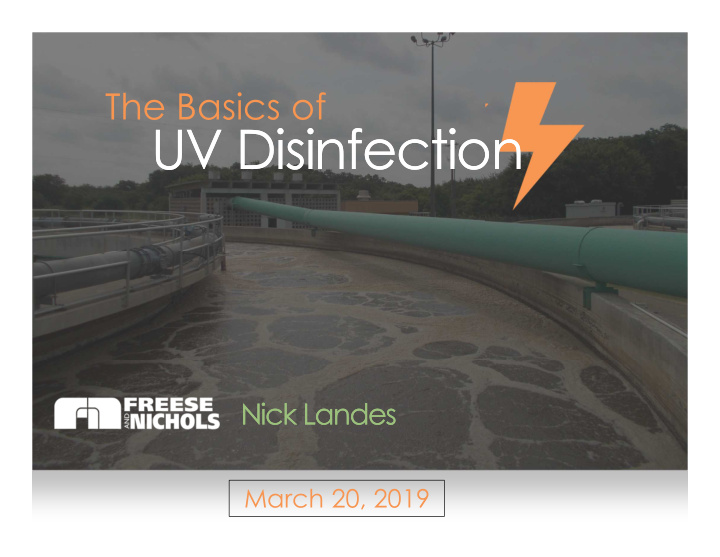



The Basics of UV Disinfection UV Disinfection Nick Landes Nick Landes March 20, 2019
Agenda What is UV How does UV Disinfect Types of UV Systems Design Considerations
What is Ultraviolet Energy 750 nm 390 nm Visible Spectrum UV Spectrum 10 nm 400 nm Germicidal Range 200 nm 300 nm Most Effective Range 265 nm 250 nm
What do we make UV? • Mercury vapor charged by electric arc inside lamp • Ionized mercury vapor emits UV irradiation
How does UV Disinfect?
UV versus Chemicals Chemical UV Disinfection Disinfection Physics Chemistry “Newer” (1910) Older (1890) No residual Residual
Types of UV Systems Vertical Horizontal Inclined Non-Contact
Design Considerations • What are your Target Microorganisms? Adenovirus Chlorine Disinfection UV Dose (mJ/cm 2 ) Rotavirus UV Dual Protection Disinfection Poliovirus Hepatitus A Giardia Crypto Legionella Streptococcus E.coli Chlorine CT Source : Keep, Terry (2013). Advances in UV Technology for 4-Log Virus Disinfection of Groundwater
Design Considerations • UV Transmittance Inorganic Compounds Compounds Found in 100% Wastewater 90% Bromine Dyes and coloring agents 80% Chlorine Humic acids Percent Less Than, % 70% Chromium Lignin sulfonates 60% Cobalt Extracts from leaves 50% Iodides Orzan S 40% Iron Phenolic compounds Manganese Sunblock PABA 30% Nickel Tea, Coffee 20% Sulfates Carbamide compounds 10% Stanous Choride Sodium Thiosulfate 0% 0 20 40 60 80 100 Source : Sakamoto, G. (1999). UV Transmittance, Trojan UVT , % Technologies, Inc. Example for UVT 60% 75% 34 MGD Lamps 96 64 System Max Power 100 65 Draw, kW Cost $820k $540k
Design Considerations • Flow Patterns 4.5 9 4 8 Inflow to the Plant , MGD 3.5 7 Number of Rows Online 3 6 2.5 5 2 4 1.5 3 1 2 0.5 1 0 0 0:00 6:00 12:00 18:00 0:00 Time (hrs)
Design Considerations • Protect the UV System with Upstream Filtration
Design Considerations • Look at the Life Cycle… not just Capital Costs
Questions? Nick Landes , Ph.D., P.E. nick.landes@freese.com (817) 735-7571
Recommend
More recommend